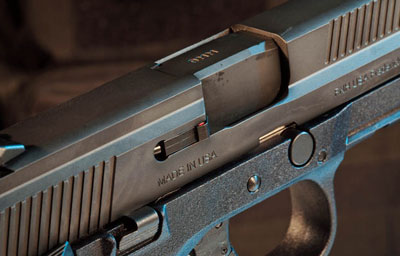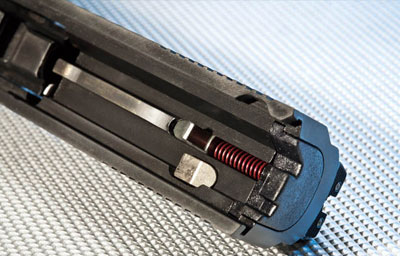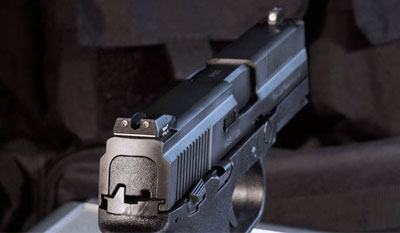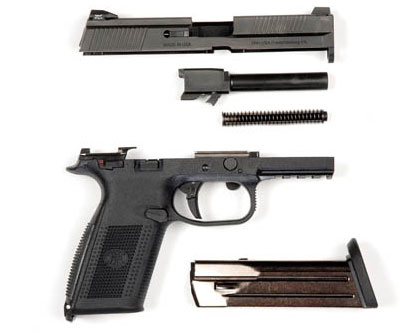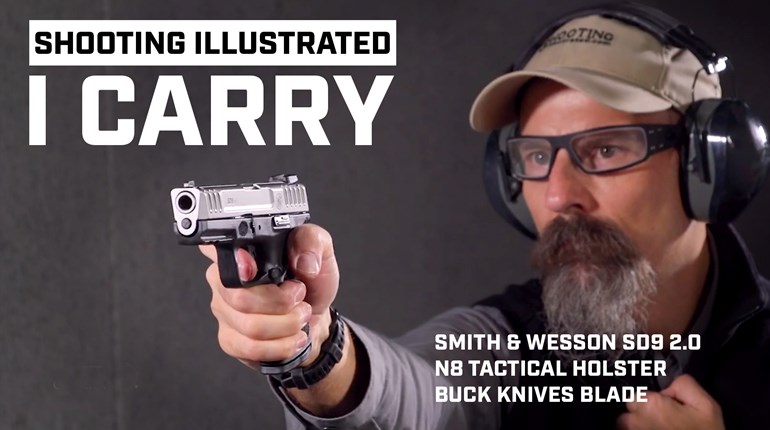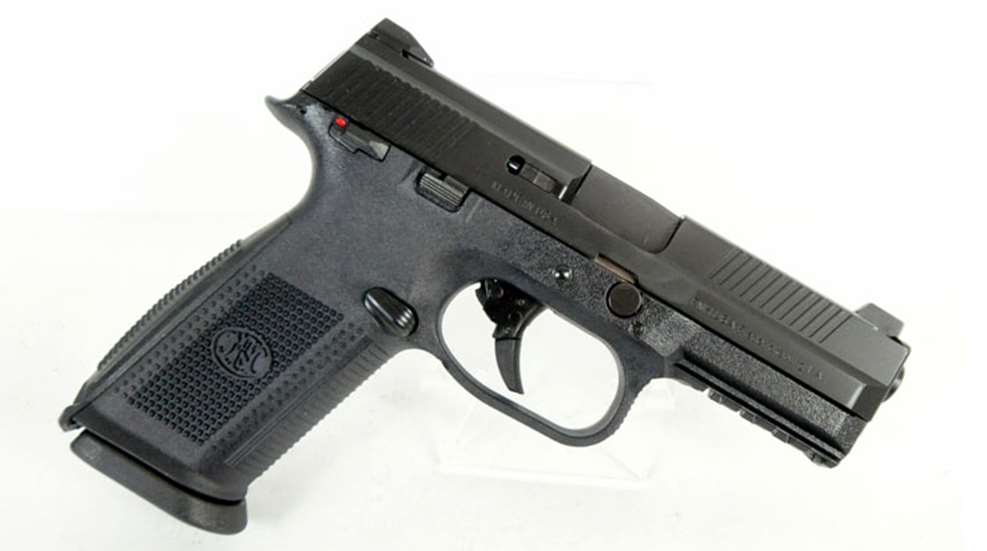
Since cops started carrying handguns, their needs and preferences have driven the defensive handgun market. FNH USA's latest defensive handgun, the FNS-9, is a perfect example of this trend. The FNS-9 incorporates many features attractive to law enforcement agencies. These same attributes make the pistol just as appealing to armed citizens and competitive shooters.
We're living in the age of the modern pistol, which is typified by a polymer frame and a striker firing mechanism. Some like it. Others long for the days when pistols were made of steel. The majority of cops don't care—most cops are not gun guys like many believe. Modern police officers want a pistol that is reliable, accurate, comfortable to shoot and light enough to carry all day, every day. Most cops would like to start their shift with a .44 Mag. By shift's end, they're ready to trade it for a .22. It wasn't always like that.
Back in the day, cops were big men with big hands. It was easy for departments to arm their offi-cers with a single handgun model because most were about the same size. Cops complaining their pistol was too heavy got jail duty or became car salesmen. There might have been a few Barney Fifes, but there were no women wearing a badge. Not all that long ago, diversity was unheard of. Modern cops are men and women, some as big and ugly as Brock Lesnar, others as petite and eye-catching as Eva Longoria. It's the ability of the FNS-9 to comfortably interface with this diverse mix that will make agencies take notice.
This is primarily accomplished with the polymer frame, which has a grip angle identical to a 1911. There's also a wide and high beavertail that allows for a low bore axis. Like the 1911, backstraps are interchangeable. Each pistol is shipped with two—one flat, one arched. Just as with the rest of the grip's surface, the backstraps have very aggressive pebbling or checkering molded in. This might sound uncomfortable; however, due to fear of cuts, punctures and blood-borne diseases, most street officers now wear some sort of gloves. The assertive checkering helps gloved hands hang on.
Both backstraps also have an integral lanyard loop. Lanyards on police pistols are a thing of the past and really have no purpose on defensive handguns, though some special law enforcement teams, particularly those with water-centric missions, should appreciate this feature. If you carry a pistol on your bass boat—just in case of a pirate attack—you'll appreciate it, too. Regardless, the lanyard loop is unobtrusive.
To sort out the lefty-righty problem, FNH USA equipped the FNS-9 with an ambidextrous magazine release. It's in the usual location and works identically from either side. According to my thumbs, it was easier to depress from the left than from the right, but the difference was minimal. The magazine release was also large, more than a half-inch long and a quarter-inch wide.
It was not perfect, at least in my hands. In fact, it constituted the only real flaw I found with the pistol. The ergonomics of this pistol are outstanding, and I could depress the magazine release with my shooting-hand thumb without altering my grip. But when I did, the magazine-release button on the opposite side pushed out against the middle finger of my shooting hand and prevented complete magazine disengagement. I had to alter my grip to complete the process.
Being totally ambidextrous was the design criteria for the FNS-9, and this diverse concept extends to the slide lock. One is positioned on each side of the pistol, where it can easily be reached with the thumb of the shooting hand. Whether you train to use the slide lock as a slide release or not, with the FNS-9 you have that option, regardless of which hand the pistol is in. The slide lock on the left side, like the magazine release, was easier to actuate.
The thumb safety is also ambidextrous and is positioned in the common location. Up is safe, down is fire. This is just a safety; it does not lock the slide like on a 1911, which means the FNS-9 can be loaded while on safe. Surprisingly, the safety is the smallest control on this pistol. It's only a half-inch long and protrudes a mere 0.17 inch beyond the side of the slide. My initial speculation was it was too small. However, I ran the FNS-9 through a dozen or so defensive pistol drills and not once did my thumb fail to disengage it, even when gloved.
The only non-ambidextrous control lever or button is the takedown lever. It is .9 inch long and fits flush with the frame on the left side. Field stripping is easy. Completely unload the pistol and lock the slide to the rear. Rotate the takedown lever 90 degrees down, hold on to the slide and depress the slide lock. Ease the slide forward, press the trigger and pull the slide from the fame. You can then remove the captive recoil spring and barrel from this linkless, locked-breach, recoil-operated pistol.
Not only is the FNS-9 ambidextrous, it can be employed with the same diversity you will find among police officers. On the bottom of the frame, just forward of the large trigger guard, lies an integral accessory rail with four slots. This could be used for the attachment of a Crimson Trace Rail Master laser or a SureFire weaponlight. The rail extends the serviceability of the FNS-9 from just a duty weapon to a tactical-team sidearm.
The other, and maybe most important, frame-mounted control is the trigger. The FNS-9's trigger is .38 inch wide and smooth. It's a jointed affair with a bottom section that must be engaged with the finger before the trigger can be pulled to release the striker. If the bottom section of the trigger is not depressed, an extension of that section engages the pistol's frame and prevents rearward movement of the trigger.
This is a revolver-like, pivoting trigger with a very audible and precise reset. The trigger was consistent and smooth, but heavy. After shooting, 10 pulls with Timney Triggers' trigger-pull gauge showed an average pull weight of 8 pounds with only .25 pound of variation. Out of the box, this was not the case. To my fingers it seemed to have an inconsistent pull and seemed to break at different locations during dry-fire. I'm sort of at a loss to explain this issue. During the first magazine I fired from the FNS-9, the trigger felt just fine except for one shot. This was a slow-fire session to get acquainted with the pistol, and I was paying particular attention to the trigger. That one pull felt a bit mushy and released the striker at the rearward extent of its travel. After that, during the firing of 75 rounds from the bench and another 225 rounds through various drills, the trigger felt, well, normal for a striker-fired pistol.
I only mention the out-of-the-box, weird-feeling trigger because it's my intention to keep the review objective and honest. Maybe it was so early in the morning my fingers were not completely awake, or maybe I was having a Glock flashback from my uniform days. Whatever the cause, after the first magazine was fired I never experienced the weird-feeling trigger again, and it did not adversely affect my shooting.
Results tell the tale. I subjected the FNS-9 to my standard test drill: the Forty-Five. This is a five-shot drill from the holster with the goal of putting all bullets inside a 5-inch circle at 5 yards in 5 seconds. I passed on my first run and the next three. No problems there. I also flipped all six plates on an Action Target Dueling Tree at 10 yards in just a shade more than 4 seconds. No misses mind you. My 12-year-old son also did well on the dueling tree, going five for six on his first run, which took him about twice the time.
There are a few other aspects of the FNS-9 that should be addressed. The magazine well has a moderately wide bevel. This is appreciated when you're trying to hastily shove a new 17-round magazine in the pistol. And, this bevel is not just internal; it extends to the outside of the grip and sort of provides a shelf to rest the bottom of your hand. I really liked this feature because it made it almost impossible to pinch the tender part of my hand between the magazine base pad and grip frame.
I've never demanded a loaded-chamber indicator on a handgun. However, a loaded-chamber indicator does have merit. It can serve as confirmation that, when you have attempted to chamber a cartridge, a cartridge actually has been chambered. This precludes the necessity for a press-check. Press-checks are a handgun manipulation I believe best left off most law enforcement training ranges unless the department has a comprehensive—at least quarterly—training program. Most do not.
On the FNS-9, the extractor serves as the loaded-chamber indicator. When a cartridge is in the pistol's chamber the extractor protrudes .06 inch out from the side of the slide. This may seem inconsequential, but it's plenty to easily feel. In addition to being able to feel the extractor when the pistol is loaded, the top of the extractor is colored red, so in decent light you have visual confirmation, too. Whether you like a loaded-chamber indicator or not, the one on the FNS-9 is not obtrusive and I'm willing to bet that you'll come to appreciate it. If you still want to look range-ninja-cool on the firing line, go ahead and do your press-checks.
Front and rear grasping grooves have been machined into the slide and provided plenty of texture for slide operation or press-checks. The slide on the FNS-9 measures exactly 1 inch wide, but is narrower at the top than the bottom. It is also devoid of sharp edges, which will be appreciated during weapon-manipulation drills and concealed carry. And, for the patriotic among us, "Made in USA" is engraved on the slide along with "FNH USA Fredericksburg VA."
Sights are of a combat configuration with a nice, tall, easy-to-see front blade that's almost .25 inch high. I like robust, sharp-edged front sights. They're easier to see, and if a bad guy grabs a policeman's pistol by the muzzle, that sharp front blade will help him rip it from the bad guy's hand. The blade has a white-outlined, tritium vial from Trijicon inserted in the center top half and the rear sight has Trijicon inserts without a white outline. This provides a three-dot system that seems to be the law enforcement standard. The rear sight is a wedge-shaped affair with a deep U-notch. My eyes would have liked to have seen the notch a tad wider, but I don't see eye to eye with my eyes like I used to.
As a police pistol, I believe the FNS-9 has a great deal going for it. Of course, that opinion is coming from a man who no longer wears a badge—though I did spend most of my law enforcement career training other police officers how to shoot. From that perspective, I'm confident the FNS-9 has validity as a police service weapon. The design has been subjected to and passed a 25,000-round torture test. Most agencies and civilian shooters will replace their pistol well before it consumes that much ammo.
Concisely speaking, the FNS-9 will fit most any officer's hand. It has a manual safety—a safety small enough to be ignored if you feel it's something that has no place on a duty handgun. It's completely ambidextrous and has a very healthy magazine capacity. It's also compatible with gloved hands and, due to the accessory rail, the FNS-9 will be user friendly to tactical entry teams.
Some may balk at the 9 mm chambering. If you do, a .40 S&W version is in the works. I consider this of little consequence. Years of conducting terminal performance testing has shown the best 9 mm +P loads drive as deep and damage just as much tissue as most .40 S&W or even .45 ACP loads. To find any perceived advantage with either of these larger-caliber cartridges, you'll have to step up to a stouter-recoiling load—one that probably won't be appreciated or be as controllable by some of today's law enforcement personnel.
Of course, FNH USA did not intend for the FNS-9 to be a police-only handgun. For many of the same reasons a police department adopts a duty handgun, so do citizens looking for personal protection. If you think modern police departments are diverse—around 10 percent of police officers are women—consider the diversity of the civilian population at large.
With the FNS-9, FNH USA set out to design a reliable and accurate duty-size pistol that would successfully interface with the widest selection of police officers and training doctrines being employed. I find it hard to argue the company has done anything less. For those same reasons, the FNS-9 should also interface well with a wide range of civilians who want to be armed for protection or various sport-shooting disciplines. The FNS-9 continues the evolution of the modern pistol, and it does so without prejudice.
Manufacturer: FNH USA; (703) 288-3500, fnhusa.com
Action Type: Recoil-operated, semi-automatic
Caliber: 9 mm
Capacity: 17+1 rounds
Frame: Polymer
Slide: Stainless steel
Finish: Matte black
Barrel Length: 4 inches
Rifling: 6 grooves; 1:10-inch RH twist
Grips: Polymer, interchangeable backstraps
Sights: Three-dot tritium
Trigger Pull Weight: 8 pounds
Length: 7.25 inches
Width: 1.55 inches
Height: 5.5 inches
Weights: 25.2 ounces
Accessories: Hard-plastic case, three magazines
MSRP: $699.99
